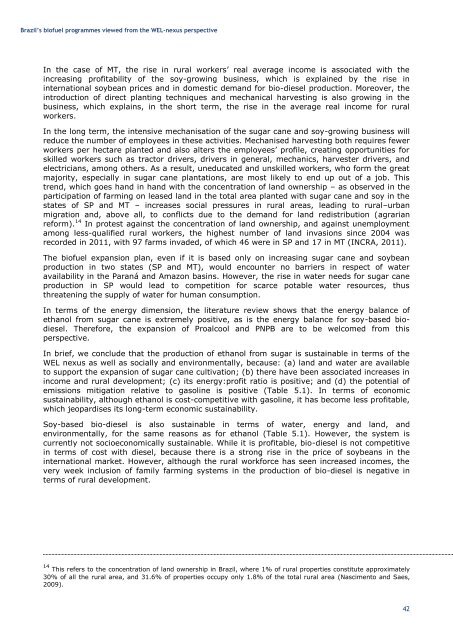Brazilian Biofuels Programmes from the WEL Nexus Perspective
Brazilian Biofuels Programmes from the WEL Nexus Perspective
Brazilian Biofuels Programmes from the WEL Nexus Perspective
- No tags were found...
You also want an ePaper? Increase the reach of your titles
YUMPU automatically turns print PDFs into web optimized ePapers that Google loves.
Brazil’s biofuel programmes viewed <strong>from</strong> <strong>the</strong> <strong>WEL</strong>-nexus perspectiveIn <strong>the</strong> case of MT, <strong>the</strong> rise in rural workers’ real average income is associated with <strong>the</strong>increasing profitability of <strong>the</strong> soy-growing business, which is explained by <strong>the</strong> rise ininternational soybean prices and in domestic demand for bio-diesel production. Moreover, <strong>the</strong>introduction of direct planting techniques and mechanical harvesting is also growing in <strong>the</strong>business, which explains, in <strong>the</strong> short term, <strong>the</strong> rise in <strong>the</strong> average real income for ruralworkers.In <strong>the</strong> long term, <strong>the</strong> intensive mechanisation of <strong>the</strong> sugar cane and soy-growing business willreduce <strong>the</strong> number of employees in <strong>the</strong>se activities. Mechanised harvesting both requires fewerworkers per hectare planted and also alters <strong>the</strong> employees’ profile, creating opportunities forskilled workers such as tractor drivers, drivers in general, mechanics, harvester drivers, andelectricians, among o<strong>the</strong>rs. As a result, uneducated and unskilled workers, who form <strong>the</strong> greatmajority, especially in sugar cane plantations, are most likely to end up out of a job. Thistrend, which goes hand in hand with <strong>the</strong> concentration of land ownership – as observed in <strong>the</strong>participation of farming on leased land in <strong>the</strong> total area planted with sugar cane and soy in <strong>the</strong>states of SP and MT – increases social pressures in rural areas, leading to rural–urbanmigration and, above all, to conflicts due to <strong>the</strong> demand for land redistribution (agrarianreform). 14 In protest against <strong>the</strong> concentration of land ownership, and against unemploymentamong less-qualified rural workers, <strong>the</strong> highest number of land invasions since 2004 wasrecorded in 2011, with 97 farms invaded, of which 46 were in SP and 17 in MT (INCRA, 2011).The biofuel expansion plan, even if it is based only on increasing sugar cane and soybeanproduction in two states (SP and MT), would encounter no barriers in respect of wateravailability in <strong>the</strong> Paraná and Amazon basins. However, <strong>the</strong> rise in water needs for sugar caneproduction in SP would lead to competition for scarce potable water resources, thusthreatening <strong>the</strong> supply of water for human consumption.In terms of <strong>the</strong> energy dimension, <strong>the</strong> literature review shows that <strong>the</strong> energy balance ofethanol <strong>from</strong> sugar cane is extremely positive, as is <strong>the</strong> energy balance for soy-based biodiesel.Therefore, <strong>the</strong> expansion of Proalcool and PNPB are to be welcomed <strong>from</strong> thisperspective.In brief, we conclude that <strong>the</strong> production of ethanol <strong>from</strong> sugar is sustainable in terms of <strong>the</strong><strong>WEL</strong> nexus as well as socially and environmentally, because: (a) land and water are availableto support <strong>the</strong> expansion of sugar cane cultivation; (b) <strong>the</strong>re have been associated increases inincome and rural development; (c) its energy:profit ratio is positive; and (d) <strong>the</strong> potential ofemissions mitigation relative to gasoline is positive (Table 5.1). In terms of economicsustainability, although ethanol is cost-competitive with gasoline, it has become less profitable,which jeopardises its long-term economic sustainability.Soy-based bio-diesel is also sustainable in terms of water, energy and land, andenvironmentally, for <strong>the</strong> same reasons as for ethanol (Table 5.1). However, <strong>the</strong> system iscurrently not socioeconomically sustainable. While it is profitable, bio-diesel is not competitivein terms of cost with diesel, because <strong>the</strong>re is a strong rise in <strong>the</strong> price of soybeans in <strong>the</strong>international market. However, although <strong>the</strong> rural workforce has seen increased incomes, <strong>the</strong>very week inclusion of family farming systems in <strong>the</strong> production of bio-diesel is negative interms of rural development.14 This refers to <strong>the</strong> concentration of land ownership in Brazil, where 1% of rural properties constitute approximately30% of all <strong>the</strong> rural area, and 31.6% of properties occupy only 1.8% of <strong>the</strong> total rural area (Nascimento and Saes,2009).42
















